Forex reserves rise $377m in a week

Bangladesh's foreign currency reserves rose $377 million in a week to about $20.57 billion, central bank figures showed.
The Bangladesh Bank data was based on calculations made in line with the formula of the International Monetary Fund (IMF).
The forex reserve stood at $20.19 billion a week earlier.
The gross reserves have increased over the past two weeks after the central bank initiated currency swaps with commercial banks.
The move was designed to enable the BB to meet the net reserve condition set by the IMF as part of its $4.7 billion loan programme.
Under the currency swap deal, commercial banks can take local currency from the central bank in exchange for US dollars for a tenure ranging from seven days to 90 days.
The BB has secured over $400 million from nearly 12 banks under the currency swap mechanism since its introduction, said a senior official of the central bank seeking anonymity.
The central bank has sold US dollars from its reserves only to settle the import bills of state-run enterprises.
In the post-pandemic period in 2021, the country's import payments started to rise faster than remittance inflow and exports earnings, prompting a shortage of US dollars in banks.
The forex crisis intensified in the middle of 2022 due to the price hike of essential goods and commodities on the global market because of supply chain disruptions caused by the lingering impacts of the pandemic and the outbreak of the Russia-Ukraine war.
In order to help banks settle record import bills,the central bank pumped more than $28 billion into the banking sector from its reserves, which caused the reserves to halve in just two years.
Owing to the sharp fall in the reserves, Bangladesh failed to meet the IMF minimum net international reserve target of $17.78 billion as of December 31.
Industry people, however, think the forex crisis will ease soon as merchandise exports rebounded strongly in January after manufacturers shipped goods worth $5.72 billion, a single-month record. Similarly, remittance flow rose to a seven-month high in January.
Suppliers are also hoping to retain the momentum in the coming months.

 For all latest news, follow The Daily Star's Google News channel.
For all latest news, follow The Daily Star's Google News channel. 






Comments